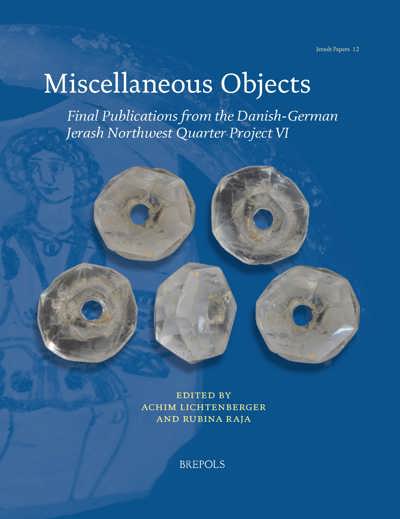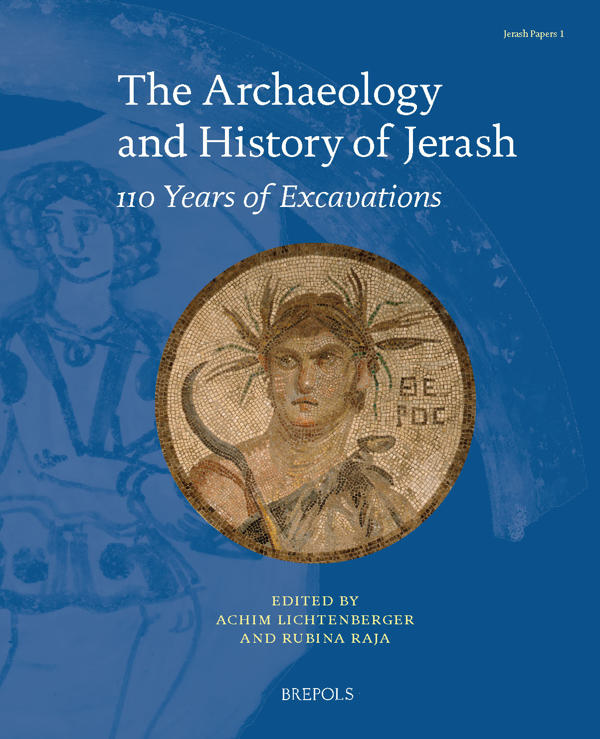
The Archaeology and History of Jerash
110 Years of Excavations
Achim Lichtenberger, Rubina Raja (eds)
- Pages: xx + 280 p.
- Size:216 x 280 mm
- Illustrations:254 b/w, 12 tables b/w.
- Language(s):English
- Publication Year:2018
- € 145,00 EXCL. VAT RETAIL PRICE
- ISBN: 978-2-503-57820-0
- Paperback
- Available
The important Decapolis Gerasa has been object of archaeological investigations since 1907. This volume brings together scholars who have undertaken research in the city within the last four decades and presents the results of these projects.
“To conclude, the volume is full of new ideas and reflections, which will undoubtedly be especially helpful to those familiar with some of the issues discussed (…) One of the strengths of the book is in fact the painstaking analysis of archaeological evidence (…) all essays are an invaluable source for scholars and students interested in taking on or extending open questions about the city of Jerash” ((Paolo Cimadomo, in Bryn Mawr Classical Review, 2019.10.47)
« A. Lichtenberger et R. Raja publient un utile ouvrage, premier d’une nouvelle collection, réunissant une quinzaine de contributions dues à la fois aux vétérans de l’archéologie de la ville et à une jeune génération de chercheurs. C’est là une excellente initiative (…) En définitive, ce volume se révèle extrêmement utile en ce qu’il présente du matériel inédit, soulignant au passage la grande quantité de données produites par diverses équipes qui attendent toujours d’être publiées, et l’importance de ces informations, mises au jour dès le début du XIXe siècle, à intégrer dans une synthèse qui... reste à écrire. Index. » (Laurent Tholbecq, dans L'Antiquité Classique, 88, 2019, p. 456-459)
“(…) the reviewer honours the work of Lichtenberger and Raja. They are undoubtedly very much interested and concerned about ancient Gerasa. One of the strength of this volume is the many ideas and reflections on old and new research undertaken in relation to the archaeology and history of Gerasa.” (Lucas Petit, in BIBLIOTHECA ORIENTALIS, LXXVII N° 3-4, 2020, p. 369)
110 years ago, archaeologists for the first time began work in the Decapolis city of Gerasa, situated in modern northern Jordan. It was the start of intensive research into this extraordinary city’s archaeology and history that continued through large-scale excavations in the 1920s and 1930s, followed by a number of international projects, including the Jerash Archaeological Project of the 1970s and 1980s, and most recently, the Danish-German Jerash Northwest Quarter Project, begun in 2011. Over the decades, these excavations have revealed unique insights into the development of an urban space across more than a millennium, from the public monuments of the Graeco-Roman city, the introduction of the first Christian churches, and the later changes introduced in the Early and Middle Islamic periods, up to the city’s destruction by the earthquake of 749 CE and its resettlement in the Medieval period.
This volume draws together contributions by researchers who have worked in Jerash over the last decades and offers updated insights into the city and its evolution, as well as the way in which archaeology as a discipline has transformed. Discussions included in this volume cross disciplinary and chronological boundaries and transcend traditional approaches to urban archaeology in order to trace the long-term transformation of Jerash and the evolution of the city’s surrounding hinterland. The volume thus provides new perspectives on the development of Jerash within the context of the Hellenistic, Roman, Islamic, and Medieval worlds, and provides a forum for well-grounded scholarly discussion.
List of Illustrations
Abbreviations
The Archaeology and History of Jerash: 110 Years of Excavations — An Introduction — ACHIM LICHTENBERGER & RUBINA RAJA
The Neolithic Site of Tell Abu Suwwan in Jerash, Jordan — MAYSOON AL-NAHAR
A Byzantine thermopolium on the Main Colonnaded Street in Gerasa — DANIELA BALDONI
Abbasid Jerash Reconsidered: Suburban Life in Jerash’s Southwest District over the Longue Durée — LOUISE BLANKE
The Role of Landscape in the Occupational History of Gerasa and its Hinterland — DAVID D. BOYER
The Artemis Temple Reconsidered — MASSIMO BRIZZI
Un Romain à Gerasa : une inscription grecque trouvée dans les fouilles de l’hippodrome — PIERRE-LOUIS GATIER
Jerash Seen from Below. Part Two: Aspects of Urban Living in Late Antiquity — INA KEHRBERG-OSTRASZ
The ‘Great Eastern Baths’ of Jerash/Gerasa: Balance of Knowledge and Ongoing Research — THOMAS LEPAON, NIZAR TURSHAN, & THOMAS M. WEBER-KARYOTAKIS
A View of Gerasa/Jerash from its Urban Periphery: The Northwest Quarter and its Significance for the Understanding of the Urban Development of Gerasa from the Roman to the Early Islamic Period — ACHIM LICHTENBERGER & RUBINA RAJA
The Early Research History of Jerash: A Short Outline — EVA MORTENSEN
Recent Italian Restoration Work and Excavation in the Sanctuary of Artemis 2008–14 — ROBERTO PARAPETTI
Working with Coins in Jerash: Problems, Solutions, and Preliminary Results — INGRID & WOLFGANG SCHULZE
Pourquoi Hadrien a-t-il passé l’hiver de 129/30 à Gerasa ? — JACQUES SEIGNE
Evergetes and Restorers of the Gerasa Μακέλλον/macellum — ALEXANDRA USCATESCU & MANUEL MARTÍN-BUENO
Urbanism at Islamic Jerash: New Readings from Archaeology and History — ALAN WALMSLEY
The Iconography of the Painted Cross Motif on Jerash Bowls — PAMELA M. WATSON
Index




